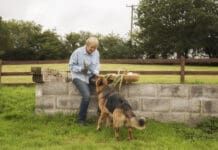[Updated December 7, 2016]
As the sole practitioner of a small animal practice encompassing massage, acupressure, homeopathy, and custom-blended flower essences, I’m always looking for products that may be effective for my clients’ animals. The most obvious, positive, long-lasting results I have seen have come from the use of acupressure, massage, and homeopathy. Yet when I heard from a third client about a product called Dog Gone Pain (“DGP” for short), I decided it was time to investigate – especially after witnessing how the client’s dogs who received the supplement enjoyed an increase in flexibility, decrease in joint pain, and obvious elevation in spirits.
I researched the ingredients in the DGP product and felt comfortable with them. I decided to try DGP on James, my 110-pound Greater Swiss Mountain Dog. If anyone needed relief from arthritis, it was James.
James came to me as a rescue at 3½ years of age. Having lived in a crate his entire life prior to his rescue, his back, rump, and thighs were terribly atrophied. I arranged for him to receive treatments by a chiropractor (which relieved much of his back pain and muscle spasms) and an acupuncturist, and placed him on a raw diet with supplements. Within a year, with a lot of physical therapy, James was easily able to take long hikes in the mountains with me.
But at about 5½ years of age, he began having an increasingly difficult time sitting down and standing up, and wasn’t as mobile, flexible, or as happy as he had been at his peak. I knew that giant breeds can exhibit health problems at what most dog owners would regard as an early age, and that they don’t always live very long, so I chalked up James’ problems to getting older.
Since I was unwilling to use the com-monly prescribed pharmaceuticals, I began the process of investigating a more holistic brand of anti-inflammatory, one without the risk of the NSAIDs (non-steroidal anti-inflammatory drugs) or corticosteroids. I tried two different nutraceutical products, without seeing any noticeable improvement in James’ pain and mobility.
That was about the time I heard about my clients’ success with DGP. I ordered some and started giving the supplement to James the moment I received it.
The results were remarkable and obvious. Within five days he was an obviously much happier dog; he was running around the backyard like a puppy! What was most amazing, though, was the change in his spirit. He was back to the old James, with no obvious sign or symptom of pain.
I kept giving DGP to James for the rest of his life. We enjoyed another two and a half years together before he succumbed to bone cancer at age 8. I credit the DGP with helping him feel good – perhaps even pain-free – throughout his illness.
Taking Responsibility as Pet Owners
There is a lot to be said for a positive anecdotal experience. My three acupressure clients were sold on DGP, based on their dogs’ experiences, and I was certain the tablets did wonders for James throughout the two-plus years he received them.
But I am also a practicing RN with 30 years of hospital experience. I understand that just because one dog – or four dogs – benefit from a therapy does not mean it will work for all or even most dogs. I appreciate and rely on data-driven, scientifically based protocols and studies to inform the decisions I make for myself and my animals – and so it gradually occurred to me that I should conduct a study involving more dogs and DGP. In fact, I felt I had a responsibility to do so.
Amazingly, I was taken seriously when I called American BioSciences (the company that holds the sole rights to distribute DGP in the U.S.) and offered to facilitate a study of DGP. Stephanie Johnson, product manager for American BioSciences, readily agreed that a formal (if small) study would help the company legitimize the terrific anecdotal accounts so frequently recounted by their grateful customers. Johnson didn’t hesitate even when I told her my goal was to write an article about the study results, regardless of the outcome. Over successive conversations, Johnson secured her company’s interest in and commitment to the project.
Then I had to find out exactly how one goes about constructing a research study!
Johnson had some ideas, I had some ideas (as an avid reader of medical studies for humans and animals), and I also asked a number of people I knew and respected about the most useful protocols for my proposed project. My friends and professional mentors, the well-known acupressure instructors and book authors Amy Snow and Nancy Zidonis, helped me a great deal, as I strived to design a trial that would demonstrate whether or not DGP really helped dogs with arthritis – and if so, how much. I wanted the dogs to be observed in their homes, throughout the course of their regular activities, by the people who knew them best – their full-time guardians. I wanted the owners to administer the supplement regularly, and then reliably report on any changes they observed in the dogs.
We agreed that the dogs in the study should have really noticeable gait, posture, and/or behavior problems that were verifiably attributable (with a veterinarian’s diagnosis) to arthritis. They should be of different breeds, sizes, ages, and activity levels, and if possible, be from different parts of the country.
We decided that the dogs’ owners would have to agree to take the dogs off all other supplements and pain medications for a week prior to and the entire duration of the study. They also had to take their dogs to a veterinarian for pre-study lab work (Lyme disease, CBC, and “super chemistry panel”) and post-study lab work (CBC and super chemistry panel).
American Biosciences agreed to pick up the tab for all this veterinary work, and to provide the owners with DGP for the study dogs at no cost.
Once I had the study architecture planned, I began to solicit dog owners and veterinarians for participation. Vets referred some clients. Friends and fellow acupressure practitioners put out the word on various canine listserves and bulletin boards. I talked to or exchanged e-mail with hundreds of people who were interested in the study, and finally selected 14 from a list of 87 people who expressed a strong desire to participate. I had to disqualify two dogs (a Beagle and a Lab) whom I had originally accepted for the study after pre-study testing demonstrated they were positive for Lyme disease.
Enthusiasm ran particularly high among owners of Golden Retrievers and Labradors – dogs with a high incidence of certain types of arthritis in their elder years. Because I wanted to include a range of dog breeds, sizes, activity levels, and primary diagnoses, I accepted only three Goldens, one Labrador, and one Lab-mix. I also included a Sheltie, a Pembroke Corgi, an Australian Kelpie, a terrier-mix, two Beagles, a 45-pound mixed breed, a Jack Russell Terrier, and an English Setter. The youngest dog in the study was 5 years old and the oldest was 13, with a mean age of 9 years of age.
I supplied each of dogs’ guardians with a packet of paperwork to fill out. The bulk of the work came in the beginning, as I asked them to describe their dogs’ health status in as much detail as possible, including information about age, weight, medical history, exercise/activity level, pack status, diet, appetite, elimination habits and characteristics, and much more.
I also asked the owners to rate, on a scale of 0 (defined as clinically normal) to 4 (defined as nearly incapacitated), their dogs’ lameness/ability to bear weight, joint mobility, pain on palpation of joints, and willingness to bear weight on their “good” limbs. I provided them with instructions on how to examine and handle the dog to assess these criteria.
With the pre-treatment paperwork out of the way, the weekly assignment for the owners was much less involved. At the end of each week I asked the owners to methodically assess the overall condition of the dogs: where the pain seemed to be located, what the dogs’ movement and gaits were like, how much flexibility they had, and how their behavior, attitude, or mood seemed. I also asked them to note any adverse reactions the dogs displayed – lack of appetite, vomiting, diarrhea, behavior change, dermatitis, or anything else.
At the end of the study, the owners again rated (on a scale of 0 to 4) the dogs’ physical abilities.
The recommended dosage for DGP is one tablet per 30 pounds of the dog’s body weight. Due to the severity of arthritis, all dogs in this study were started on a double-dose regimen for the first two weeks, then given the normal dosage for the remainder of the six-week trial.
Study Findings
I need to say, first off, that all the dogs in the study showed improvement while taking DGP. The first and most obvious sign of improvement in 100 percent of the participants was an elevation of spirit – the dogs seemed happier. This occurred within the first week for all the dogs. Was this due to decreased pain or a balancing effect of the herbs on all of the body systems? I don’t know. Three participating owners queried me as to whether there are any mood elevators in the ingredients of DGP; there aren’t.
All of the dogs’ owners reported seeing noticeable improvement in the dogs’ mobility, soundness, and activity levels while on the DGP. The mean onset of musculo-skeletal improvement was one to three weeks, with only one dog waiting to see a peak cumulative effect in the sixth week. The composite scores reported by all of the dog owners improved by at least one notch on the 0 to 4 scale; 70 percent improved by two or more notches.
Only one dog experienced adverse effects that could be related to the DGP; we removed the dog from the study in the second week due to reactions to the supplement, including vomiting, soft stools, and a marked increase in her environmental allergies (chewing of feet, accompanied by an increase in watery eyes). Her owner deeply regretted having to stop the DGP, as the dog’s arthritis symptoms markedly lessened while receiving the DGP, but of course, the adverse reactions warranted our actions.
It was also notable that there was no change in any of the participants’ pre- and post-study lab values. Granted, this was only a six-week trial, but it was important to document whether DGP caused any of the possible side effects caused by NSAIDs, namely liver, kidney, and hematologic abnormalities. None were seen.
In addition to the striking improvements in the dogs’ movement, several other findings in this study also bear mentioning. One is the fact that almost all of the participants assumed their dogs’ infirmities were just the natural progression of aging and that little could be done to offset the symptoms – just like I had, with James. It was not until we had seen our dogs’ improvement on DGP that we realized how crippled our dogs actually were prior to starting the supplement.
In fact, three of the participants elected to discontinue the DGP after the study was over – and then quickly started their dogs back on the supplement when the dogs’ arthritis signs dramatically resurfaced. Each expressed that they hadn’t realized how powerful the effect of DGP was until they stopped the supplement. Fortunately, the dogs were judged by their owners to be restored to a peak level of soundness and comfort within two days of being given DGP again. With the exception of the (possibly allergic) dog with the adverse response, all of the dogs are still receiving DGP today.
Last, what was glaringly obvious in this study is the effect of pain on a dog’s behavior. Qualified by their severe arthritis, the dogs were all described by their owners before the study as sleeping a lot, depressed, withdrawn from socializing with their people and pack, irritable, grouchy, and less mobile. But every single dog in this trial demonstrated an improvement in mood, demeanor, and/or attitude within the first two weeks of taking DGP.
A Future for Arthritic Dogs
This study validated my findings with James. It showed me that DGP enhanced the lives of severely arthritic dogs on many levels. In the majority of the dogs sampled (93 percent), DGP was judged by the dog owners to be as or more effective as the NSAIDs and pain medications the dogs had been given prior to the study. At this point, I feel confident in suggesting it to the guardian of any dog with arthritis.
The main caution I relate to dog owners who are considering DGP for their dogs is to make sure to initially limit the dog’s physical activity once he has been on DGP for a few days, until he gets used to feeling good. I have often seen arthritic dogs feel so much better, that they (and, unwittingly, their owners) overexercise and end up in real pain, with muscle soreness and stiffness for days. This can be avoided if the dog’s activity is moderated.
My hope now is that someone will see fit to conduct a large-scale study of the supplement. A number of holistic veterinarians I know have expressed an interest in participating.
No single product can be considered a cure-all for every canine musculoskeletal ailment. That said, I think that DGP is a great product to try as a first resort for those dogs with mobility/arthritis issues, and whose guardians do not want to assume the risk of the side effects of corticosteroids or NSAIDs.
For more information about DGP, check out the website here.
Jan Skadberg is a registered nurse and a certified legal nurse consultant. She also offers acupressure and massage for canines from “4 Paws,” her practice in Charles Town, West Virginia.







One of my Dobermans was on DGP and I definitely saw a great improvement. She is 12 years old and has spondylosis And arthritis I am sure. I had to find something else however because of cost. One bottle of DGP lasts me 20 days and I cannot afford it. I have three other dogs to purchase food and supplements for as well. I am now giving MSM and Hemp oil, both of which last me a lot longer and she is still happy and running again, not the full out Doberman run that she did when she was younger, but she is galloping through the yard.
Another plus of DGP is the turmeric and it’s cancer fighting ability. My oldest Doberman is 13 and he has spondylosis as well as arthritis and liver and spleen cancer. He is being given turkey tail mushroom, an immunity blend of other mushrooms, milk thistle, and I am now trying to find a place to purchase DGP for less. He was on Rimadyl but that has been stopped due to side effects and I wasn’t happy about that anyway, so I would like to try DGP for him for pain and also for the turmeric and it’s cancer fighting ability, along with the mushrooms.
The cost of the supplement isnt too bad but I just checked and they want to chare $45 for shipping. 🤨
Our 10-year-old terrier mix has been taking Cosequin for about 8 years to slow down arthritis due to a genetic knee condition. Recently he has started to show signs of pain: difficulty getting up and going up the stairs. We’d like to try this supplement, but cannot find a definite answer if it can be given together with Cosequin Maximum Strength with MSM, or only as a replacement. We would very much appreciate your advise.
I just got my hands on a Portable Vaporizer and it works like a dream